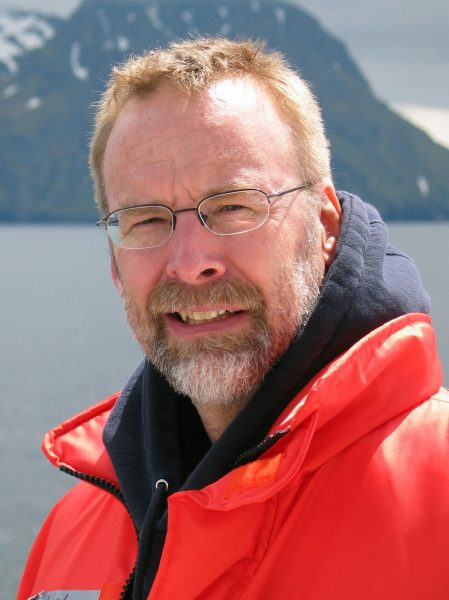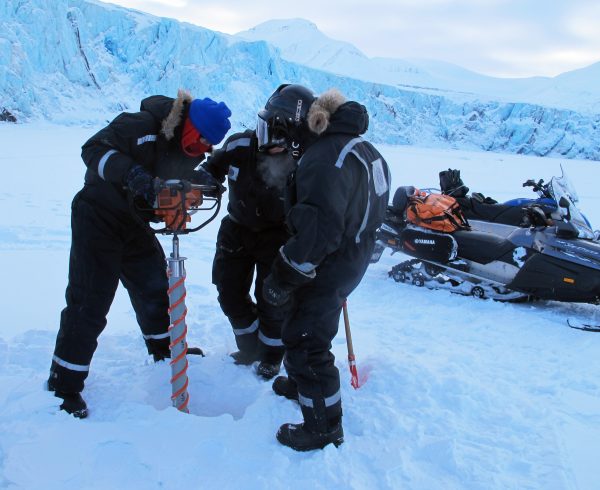Oceanography opens UAF researcher to global possibilities
July 19, 2017
Lauren Frisch
907-474-5350

Download text and photo captions here.
Mark Johnson may hold the world record for largest geographic range in which someone has practiced tai chi.
It’s hard to know for sure. But Johnson has done tai chi at McMurdo Station in Antarctica all the way north to Svalbard, a Norwegian archipelago near the North Pole. He has been practicing and instructing tai chi for almost 30 years, and uses the exercise to help stay flexible and balanced.
Johnson travels to these remote locations as a physical oceanographer for the University of Alaska Fairbanks College of Fisheries and Ocean Sciences, studying different environmental factors, including air masses, sea ice and river runoff, that make oceans behave in certain ways.
For Johnson, the northern reaches of the world are the biggest attraction.
“I am drawn to working in the Arctic,” Johnson said. “The fieldwork is so compelling. I find it amazing that my job is to figure out how Arctic systems work, to live here to observe and measure what’s going on.”
During his graduate program at Texas A&M University, Johnson studied the Antarctic Circumpolar Current, an ocean current in the Southern Hemisphere that flows around Antarctica. As a postdoctoral fellow at Florida State University, Johnson’s research focus shifted toward the equator to study the El Niño Southern Oscillation, an irregular climate pattern that drives changes in the global climate every few years.
Johnson moved to Fairbanks in 1990 to research teleconnections, or interconnected air and ocean interactions, between the equator and higher latitudes. These teleconnections can help explain how Arctic weather and ocean circulation are affected by what’s happening down at the equator, or vice versa.
Interesting and relevant research topics drove Johnson from Antarctica to the equator, and finally to UAF. But it was fieldwork in icy Arctic water that finally solidified the North as Johnson’s home and preferred region for his research.
“I have one memory of working on the ice that was truly special,” he said. “I had to get up for the midnight watch during a cruise up in the Fram Strait off Greenland. I walked on deck in the bright sun. The ice was beautiful and I realized in that moment how spectacular it is to have 24 hours of light in the summer. I had been tired and groggy, but five minutes in the blazing midnight sun woke me up. It was just too cool. I couldn’t believe this was my life.”
While research projects ebb and flow, Johnson is currently working on two projects at opposite ends of Alaska.

The first project is investigating variables that influence when sea ice forms in the fall and breaks up in the spring. This project started in Svalbard but has recently expanded to Utkiagvik, Alaska.
“Understanding when the ice breaks up from wave action in the spring or what retards its freeze-up in the fall will help us define the operational window in the Arctic,” Johnson said. “That’s a multibillion-dollar question, if you know how late you can drill or how early you can start shipping things across the Arctic. It’s hugely important both to the state and internationally.”
Johnson is also part of a team focused on revising an ocean circulation chart of Cook Inlet that was produced in 1977. This updated chart will be useful for anyone using ocean circulation to better understand ecosystem dynamics and the flow of nutrients, or track gas leaks and oil spills.
In the end, Johnson said, he wants to do good science that is relevant to society, and to do it with interesting people.
And when a research cruise gets stressful, or he finds himself spending hours working hard in the same position on a lab bench, Johnson uses tai chi as an opportunity to relax and reenergize. The ability to bring his tai chi with him wherever he goes helps him remain focused on the broader research mission.
“I feel very lucky to have a job like this,” said Johnson. “I really like knowing that I’m contributing to meaningful research that will help make people’s lives better.”


